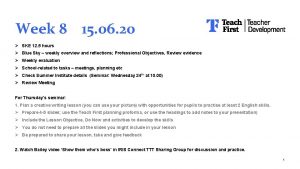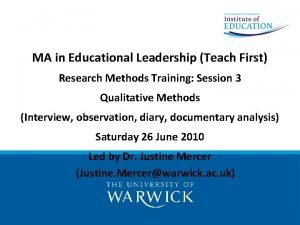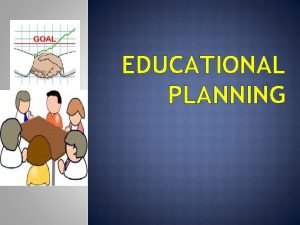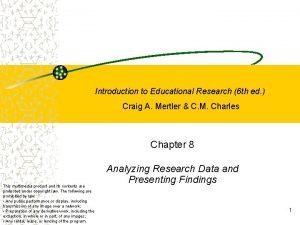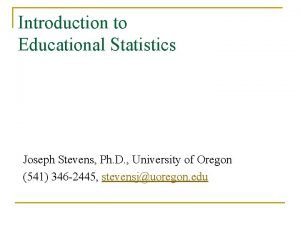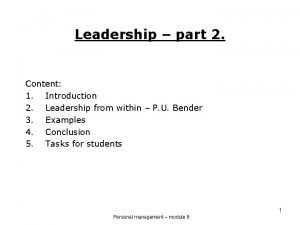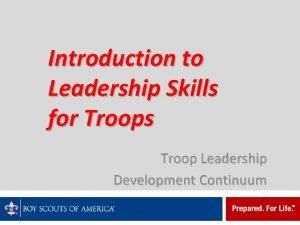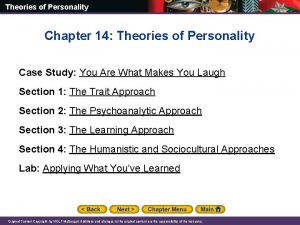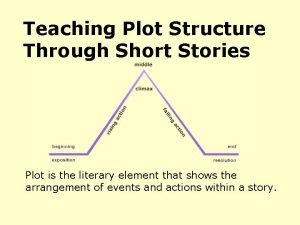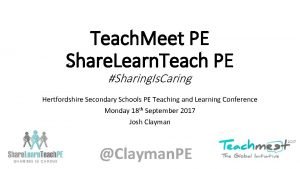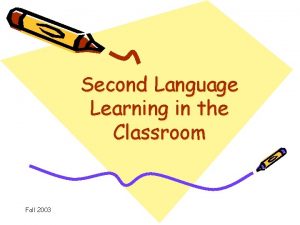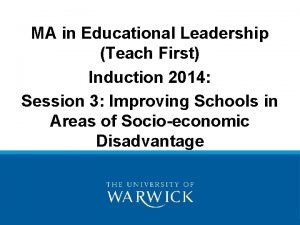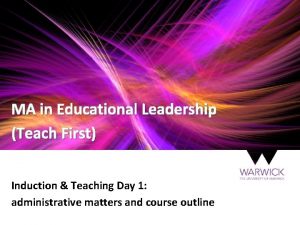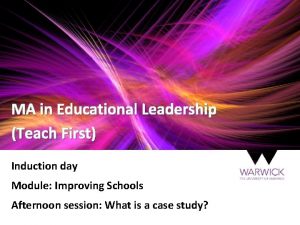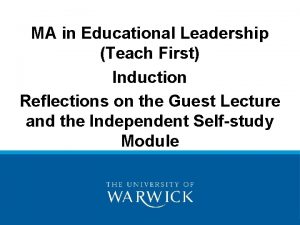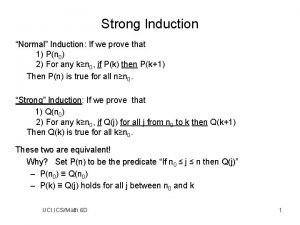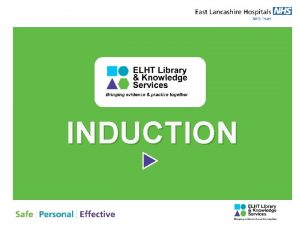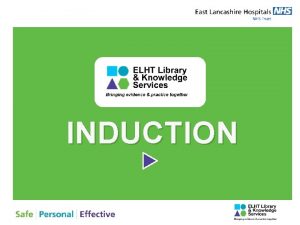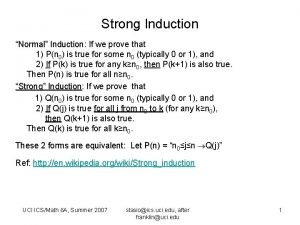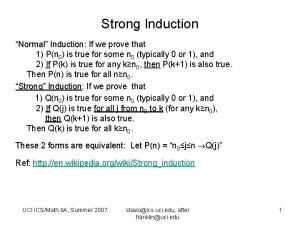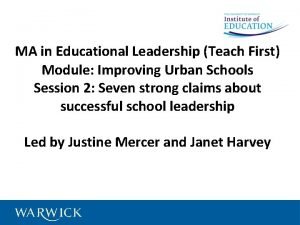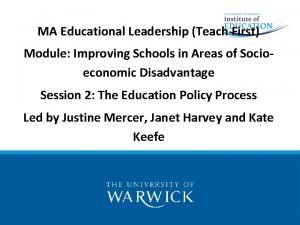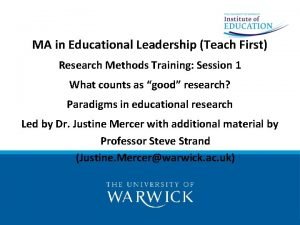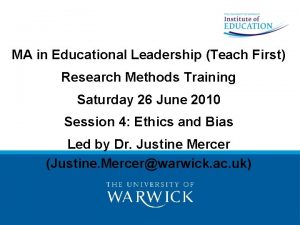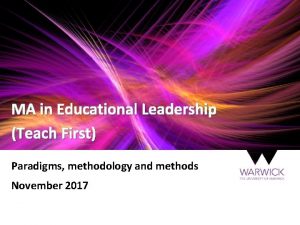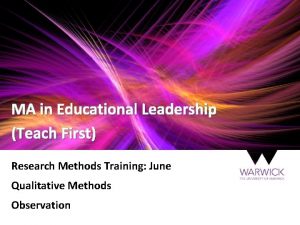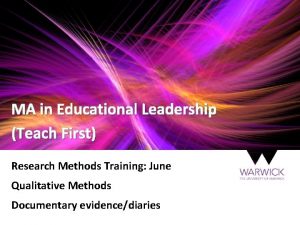MA in Educational Leadership Teach First Induction Introduction
























- Slides: 24

MA in Educational Leadership (Teach First) Induction Introduction to Case Study Research

Recommended reading Briggs, A. , Coleman, M. and Morrison, M. (eds. ) (2012) Research Methods in Educational Leadership, Third Edition, London, Sage

Activity: Confusing Terminology

Case Study ‘A case study is an enquiry which uses multiple sources of evidence. It investigates a contemporary phenomenon within its real life context, when the boundaries between phenomenon and context are not clearly evident. ’ (Johnson, 1994: 20) The ‘bounded system’ (Cresswell, 1996: 36), limited in both time and space.

Bassey (2007: 143) ‘A case study is an empirical enquiry which is: • Conducted within a localised boundary • Interesting aspects of an educational activity, programme, institution, system • In its natural context and within an ethic of respect for persons • To inform judgements and decisions of policy-makers and practitioners (or theoreticians) • Sufficient data collected for the researcher to be able to: • • Explore significant features Create plausible interpretations Test trustworthiness of these Construct a worthwhile argument or story • Relate argument or story to relevant research in the literature • Convey convincingly to an audience the argument or story • Provide an audit trail for other researchers to validate or challenge findings or construct alternative arguments

• Case study is a research approach, not a method • Most common methods are interviews, observation, and documentary analysis • Questionnaires and focus groups may also be used • Methods should be ‘fit for purpose’, not just a personal choice • Multiple methods allow for methodological triangulation

Sources of evidence • • • Direct observation Participant observation Documents Archival records Interviews Physical artefacts

Strengths of a case study • Allows in-depth investigation • Copes with complexity • Provides a ‘rounded’ picture (from the multiple sources of evidence) • Generally qualitative in nature • Methodological triangulation is ‘built-in’ • Findings are often easily understood • Good fit with small-scale research and a single researcher in a short period of time • In larger-scale research, can be combined with other approaches (e. g. a questionnaire followed by a number of case studies)

Weaknesses of a case study • Lack of ‘rigour’ • Lack of ‘generalisability’ – findings might be unique to the case • May generate a large quantity of data • Access may be uneven • Can be demanding of researcher’s time (in terms of both data collection and interpretation and analysis)

Conclusion • Case studies are very popular and ‘real’ • They are complex and require careful planning and field work flexibility • Insider research may be problematic (participant and researcher) • Using more than one method is desirable • Involving several participants is helpful

Activity: Ethics Think of a time when, as a researcher or a teacher, you faced an ethical dilemma. What was the dilemma? How did you resolve it? On what basis did you decide what to do?

Ethics in educational research • An ethical approach requires a code of conduct • See the BERA ethical guidelines (2011) • http: //content. yudu. com/Library/A 1 t 9 gr/BERAEthical Guideline/resources/index. htm? referrer. Url=http%25 253 A%25252 Fwww. yudu. com%25252 Fitem %25252 Fdetails%25252 F 375952%25252 FBERAEthical-Guidelines-2011 • See also the University of Warwick ethical approval form http: //www 2. warwick. ac. uk/fac/soc/wie/teaching/su pport/forms/masters/currentstudents

Bias from Walford (2001) describes his research into City Technology College, research that was motivated by a very strong political agenda. He believed from the outset that CTCs were wrong and was hoping to provide data that would help Labour win the next election.

Activity: Informed consent Respect for dignity and privacy a) What constitutes “informed consent”? b) Who asks participants if they would like to take part? Do they feel able to refuse? c) How much do they need to know about the research in order to give informed consent? d) What extra precautions are advisable when researching children?

Informed consent Powney and Watts (1987, p. 147) argue that research benefits from interviewees being ‘fully informed from the start of what the researchers and the interviewees are trying to establish’. More realistically, Bulmer (1982, p. 243) contends that “all field research involves giving misinformation, less than full information or even mild deceit to some extent”. Researchers need to avoid ‘contaminating’ their study “by informing subjects too specifically about the research questions to be studied” (Silverman, 2000, p. 200).

Informed consent – insider research “Thus, it seems offensive not to give some honest and reasonably full account of the rationale and purpose of one’s study to such respondents [who are equals] and the account cannot be one that is intellectually condescending. However, it is difficult to do this without inviting discussion of the study rather than getting on with the interview, and without providing so much information that it may bias the course of the interview. ” (Platt, 1981, p. 80).

Special issue with children • • • Increased responsibility on the researcher Power differential Child protection issues Who gives consent Is it informed? Issues for teachers? Parents?

Activity: Anonymity BERA (2011: 7) “The confidential and anonymous treatment of participants’ data is considered the norm for the conduct of research. ” a) What is meant by confidentiality? What is meant by anonymity? b) Should you always anonymize the institution you are describing?

Anonymity Not everyone does! • Huberty (2000) Department of Educational Psychology at The University of Georgia. • Hutchinson (1995) University of Ulster. • Miles and Hyle (1999) Oklahoma State University. • Rutherford (1992) University of Birmingham. • Even if you do use a pseudonym, it may be easy for people to guess.

Anonymity c) When quoting informants, how much information should you give about them? At what point do they become identifiable by other participants?

Confidentiality • Data provided by research participants should be kept confidential • Only the researcher should store and use data • Individuals should not be named (anonymity) • Individuals should not be identified in other ways • Participants should have the opportunity to check interview records

Activity: Sampling bias a) How can you access the voices of those who feel silenced without co-ercing them into taking part? Research into home-school partnerships relying on questionnaire sent home. Research into any topic privileging the views of those who share a common language with the researcher.

Activity: Insider research a) What are the differences between insider and outsider research? Is this a dichotomy or a continuum? b) What are the respective strengthens and weaknesses of insider and outsider research? c) What sort of ethical dilemmas are particularly acute for the insider researcher? How might you deal with them? d) How do you deal with data that has not been specifically elicited? (Incidental conversations in the staff-room, things overheard in the corridor; material left on the photocopier. )

Insider research • • • Many part-time researchers are ‘insiders’ Research and professional roles should be separate ‘Casual data should not be used Assumed knowledge should not be used ‘Inside’ role should be clarified in reports Knowledge of context versus bias and subjectivity • Mercer, J. (2007) The Challenges of Insider-Research in Educational Institutions: wielding a double-edged sword and resolving delicate dilemmas, Oxford Review of Education 33(1), 1 -17.
 Teach first planning proforma
Teach first planning proforma Teach first documentary
Teach first documentary Npl certificate in educational leadership
Npl certificate in educational leadership Slip formula
Slip formula Transactional vs transformational leadership
Transactional vs transformational leadership Adaptive leadership theory
Adaptive leadership theory Situational leadership vs adaptive leadership
Situational leadership vs adaptive leadership First educational conference 1947
First educational conference 1947 Social demand approach in educational planning
Social demand approach in educational planning Introduction to educational research mertler
Introduction to educational research mertler Introduction to educational statistics
Introduction to educational statistics Introduction to leadership
Introduction to leadership Introduction to leadership skills for troops
Introduction to leadership skills for troops L 101: introduction to health care leadership
L 101: introduction to health care leadership Introduction to leadership
Introduction to leadership Teach the writer not the writing
Teach the writer not the writing Https://teach.classdojo.com
Https://teach.classdojo.com What does the psychoanalytic approach to personality teach?
What does the psychoanalytic approach to personality teach? Chapter 10 their eyes are watching god
Chapter 10 their eyes are watching god Short stories for teaching plot
Short stories for teaching plot What is grammar
What is grammar Pe share learn teach
Pe share learn teach Lord show me your way
Lord show me your way Teach what is teachable proposal
Teach what is teachable proposal Phases of micro teaching
Phases of micro teaching
